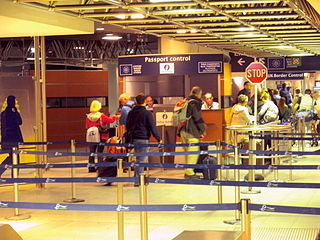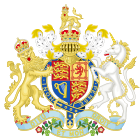
The Channel Tunnel, also known as the Chunnel, is a 50.46-kilometre (31.35 mi) underwater railway tunnel that connects Folkestone with Coquelles beneath the English Channel at the Strait of Dover. It is the only fixed link between the island of Great Britain and the European mainland. At its lowest point, it is 75 metres (246 ft) deep below the sea bed and 115 metres (377 ft) below sea level. At 37.9 kilometres (23.5 mi), it has the longest underwater section of any tunnel in the world, and is the third longest railway tunnel in the world. The speed limit for trains through the tunnel is 160 kilometres per hour (99 mph). The tunnel is owned and operated by the company Getlink, formerly "Groupe Eurotunnel".

Eurostar is an international high-speed rail service connecting the United Kingdom with France, Belgium, and the Netherlands. Most Eurostar trains travel through the Channel Tunnel between the United Kingdom and France, owned and operated separately by Getlink.

High Speed 1 (HS1), legally the Channel Tunnel Rail Link (CTRL), is a 67-mile (108 km) high-speed railway linking London with the Channel Tunnel.

Getlink, formerly Groupe Eurotunnel, is a European public company based in Paris that manages and operates the infrastructure of the Channel Tunnel between England and France, operates the Eurotunnel Shuttle train service, and earns revenue on other trains that operate through the tunnel.

The British Railways Board (BRB) was a nationalised industry in the United Kingdom that operated from 1963 to 2001. Until 1997, it was responsible for most railway services in Great Britain, trading under the brand name British Railways and, from 1965, British Rail. It did not operate railways in Northern Ireland, where railways were the responsibility of the Government of Northern Ireland.

The Channel Tunnel fire of 18 November 1996 occurred on a train carrying Heavy Goods Vehicles (HGVs) and their drivers through the Channel Tunnel from France to the United Kingdom (UK). The fire was seen on the train as it entered the tunnel and, in line with the policy at the time, an attempt was made to drive to the UK where the fire would be dealt with. However, after an indication of a serious problem with the train, the driver stopped at 21:58 CET, 19 kilometres (12 mi) into the tunnel. The locomotive and passenger coach were rapidly enveloped in thick smoke, and the locomotive lost power. Reconfiguration of the tunnel ventilation systems was delayed, but by 22:30 all passengers and crew were safe, in the service tunnel, with minor injuries.

The Office of Rail and Road (ORR) is a non-ministerial government department responsible for the economic and safety regulation of Britain's railways, and the economic monitoring of National Highways.

LeShuttle is a railway shuttle service between Coquelles in Pas-de-Calais, France and Cheriton in Kent, United Kingdom. It conveys road vehicles and passengers by rail through the Channel Tunnel. Freight vehicles are carried in separate shuttle trains hauled by the same locomotives, that also contain a passenger carriage, known as the Club Car.
Eurostar International Limited (EIL) is the railway company operating the international Eurostar train services between London, Paris, Amsterdam and Brussels via the Channel Tunnel. Eurostar was previously operated by three separate companies in Belgium, France and the United Kingdom, but this structure was replaced by EIL as a new single management company on 1 September 2010. EIL is owned by Eurostar Group.

The Eurotunnel Class 9 or Class 9000 are six-axle high-power Bo′Bo′Bo′ single-ended electric locomotives built by the Euroshuttle Locomotive Consortium (ESCL) of Brush Traction and ABB. The class was designed for and is used exclusively to haul the Le Shuttle road vehicle services through the Channel Tunnel.

London and Continental Railways (LCR) is a property development company owned by the Government of the United Kingdom for developing former railway land. The company was originally established in 1994 as a private consortium to own European Passenger Services and build the Channel Tunnel Rail Link (CTRL) under a contract agreed with the government.
This timeline outlines the key developments in the United Kingdom electricity industry from the start of electricity supplies in the 1870s to the present day. It identifies significant developments in technology for the generation, transmission and use of electricity; outlines developments in the structure of the industry including key organisations and facilities; and records the legislation and regulations that have governed the UK electricity industry.

Regional Eurostar was a planned Eurostar train service from Paris and Brussels to locations in the United Kingdom beyond London. The services would have been run using a fleet of seven North of London, 14-coach British Rail Class 373/3 trainsets.

The Rail Accident Investigation Branch (RAIB) is a British government agency that independently investigates rail accidents in the United Kingdom and the Channel Tunnel in order to find a cause, not to lay blame. Created in 2005, it is required by law to investigate accidents causing death, serious injuries or extensive damage. It also has authority to investigate incidents that could have resulted in accidents.
There are a number of proposed fixed connections—road or rail, bridge or tunnel—designed to connect the islands of Ireland and Great Britain, connect the island of Great Britain to mainland Europe, as well as to build other connections amongst the smaller islands in the British Islands.

The Channel Tunnel Rail Link Act 2008 is an Act of the Parliament of the United Kingdom which amends the Channel Tunnel Rail Link Act 1996. Its principal provision is to allow the Office of Rail Regulation to charge the operator of the Channel Tunnel Rail Link "a fee in respect of the exercise of any of the Office of Rail Regulation's functions in relation to the rail link".

The Crossrail Act 2008 is an Act of the Parliament of the United Kingdom that authorises the construction of the Crossrail railway from Maidenhead and Heathrow Airport to Shenfield and Abbey Wood. The legislation was introduced by the then Secretary of State for Transport Douglas Alexander and received Royal Assent on 22 July 2008. The Crossrail bill was introduced on 22 February 2005 and was carried over between sessions of Parliament on three occasions. Although public Bills generally pass through Parliament in a single session, this was a Hybrid Bill, which has the characteristics of both public and private bills and is subject to scrutiny in the same way as both a public and private bill, and generally takes longer to be considered. The last such hybrid bill introduced led to the Channel Tunnel Rail Link Act 1996.

Iris 320 is a modified TGV train operated by SNCF International as a dedicated track recording train for high-speed railways. The train can run at 320 kilometres per hour (199 mph) and consists of two power cars and eight trailer coaches, providing a 160-metre long laboratory. It was converted from former SNCF TGV Réseau passenger train number 4530.

Juxtaposed controls are a reciprocal arrangement between Belgium, France, the Netherlands and the United Kingdom whereby border controls on certain cross-Channel routes take place before boarding the train or ferry, rather than upon arrival after disembarkation. With the exception of the Eurotunnel Shuttle route, customs checks remain unaffected by juxtaposed immigration controls and continue to take place upon arrival after disembarkation. Belgium, France and the Netherlands are all member states of the European Union and part of the border-free Schengen Area. The United Kingdom, on the other hand, has never participated in the Schengen Area, even when it was a member state of the European Union. As a result, juxtaposed controls aim to increase the convenience and efficiency of border checks when travelling by train or ferry between the Schengen Area and the UK by removing the need for immigration checks on arrival and by streamlining checks on departure. At the same time, juxtaposed controls are intended to detect and prevent illegal immigration. In 2016, there were over 56,000 instances when people were refused entry to the UK at the juxtaposed controls.
















